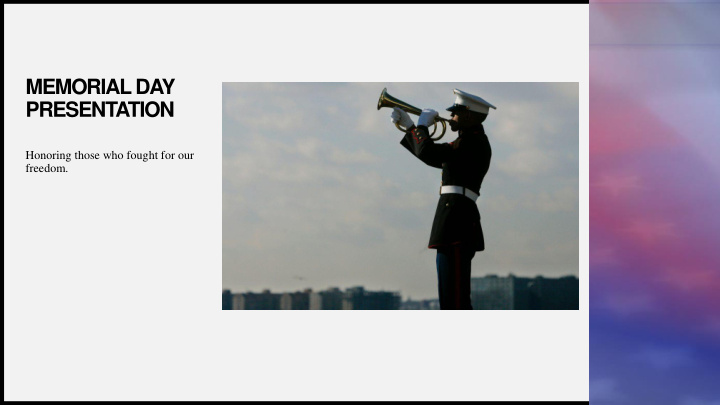



MEMORIAL DAY PRESENTATION Honoring those who fought for our freedom. FIRST UP 1 CONSUL TANTS
COLOR GUARD Creating a great Color Guard is the first step to producing a moving and respectful Memorial Day Ceremony. Remember a few rules: The American flag always flies at stage left, and never dips. If using the rest of the Military Service Flags, there is an order to where every flag is flown. US, Army, Marine Corps, Navy, Air Force, and Coast Guard. Reverent is the tempo for the Flag procession. Music, Drum or Song will make the colors ceremony moving. FIRST UP 2 CONSUL TANTS
INVOCATION A prayer to bless the proceedings is always appropriate. Example: Heavenly Father, we come to you today asking for your guidance, wisdom, and support as we begin this Memorial ceremony. Simple is better. FIRST UP 3 CONSUL TANTS
HISTORY Having the Emcee give the History of Memorial day is important to remember. Originally known as Decoration Day, it originated in the years following the Civil War and became an official federal holiday in 1971. Many Americans observe Memorial Day by visiting cemeteries or memorials, holding family gatherings and participating in parades. ... The History of Memorial Day, as Decoration Day gradually came to be known, originally honored only those lost while fighting in the Civil War. We now honor those fallen in any war or even tragic events tended to by 1 st responders. FIRST UP 4 CONSUL TANTS
EARLY OBSERVATIONS The Civil War, which ended in the spring of 1865, claimed more lives than any conflict in U.S. history and required the establishment of the country’s first national cemeteries. By the late 1860s, Americans in various towns and cities had begun holding springtime tributes to these countless fallen soldiers, decorating their graves with flowers and reciting prayers. Did you know? Each year on Memorial Day a national moment of remembrance takes place at 3:00 p.m. local time. It is unclear where exactly this tradition originated; numerous different communities may have independently initiated the memorial gatherings. And some records show that one of the earliest Memorial Day commemoration was organized by a group of freed slaves in Charleston, South Carolina less than a month after the Confederacy surrendered in 1865. Nevertheless, in 1966 the federal government declared Waterloo, New York, the official birthplace of Memorial Day. FIRST UP 5 CONSUL TANTS
GUN SALUTES A 21-gun salute is the most recognized of the customary gun salutes that are performed by the firing of cannons or artillery as a military honor. The custom stems from naval tradition, where a warship would fire its cannons harmlessly out to sea until all ammunition was spent to show that it was disarmed, signifying the lack of hostile intent. As naval customs evolved, 21 guns came to be fired for heads of state, or in exceptional circumstances for heads of government, with the number decreasing with the rank of the recipient of the honor. 21 guns are now used to honor fallen soldiers as the highest honor bestowed a fallen hero. FIRST UP 6 CONSUL TANTS
SPEECH , STORY OR PRESENTATION A Keynote speaker is a great idea here. A veteran with a good story or a story from history you would like to tell. Words from a past President are always a good choice. Example: “Today we are here to celebrate and to honor and to commemorate the dead and the living, the young men who in every war since this country began have given testimony to their loyalty to their country and their own great courage.” JFK --- FIRST UP 7 CONSUL TANTS
TAPS The origins of “Taps,” the distinctive bugle melody played at U.S. military funerals and memorials and as a lights-out signal to soldiers at night, date back to the American Civil War. In July 1862, U.S. General Daniel Butterfield and his brigade were camped at Harrison’s Landing, Virginia, recuperating after the Seven Days Battles near Richmond. Dissatisfied with the standard bugle call employed by the Army to indicate to troops it was time to go to sleep, and thinking the call should sound more melodious, Butterfield reworked an existing bugle call used to signal the end of the day. After he had his brigade bugler, Private Oliver Wilcox Norton, play it for the men, buglers from other units became interested in the 24-note tune and it quickly spread throughout the Army, and even caught on with the Confederates. FIRST UP 8 CONSUL TANTS
TAPS CONT . Not long after Butterfield created “Taps,” it was played for the first time at a military funeral, for a Union cannoneer killed in action. The man’s commanding officer, Captain John Tidball, decided the bugle call would be safer than the traditional firing of three rifle volleys over the soldier’s grave, a move which couldn’t been confused by the nearby enemy as an attack. As for the name “Taps,” the most likely explanation is that it comes from the fact that prior to Butterfield’s bugle call, the lights -out call was followed by three drumbeats, dubbed the “Drum Taps,” as well as “The Taps” and then simply “Taps.” When Butterfield’s call replaced the drumbeats, soldiers referred to it as “Taps,” although this was an unofficial moniker, according to “Taps” historian and bugle expert Jari Villanueva. He notes that Butterfield’s bugle call was officially known as “Extinguish Lights” in American military manuals until 1891. Since that time, “Taps” also has been a formally recognized part of U.S. military funerals. FIRST UP 9 CONSUL TANTS
TAPS HAS LYRICS FIRST UP 10 CONSUL TANTS
BENEDICTION FIRST UP 11 CONSUL TANTS
CONCLUSION COLOR GUARD REFORM At this time recall the colors and end your ceremony. You can preform a folding of the American Flag or simply march it off stage. You will then be congratulated for a moving and respectful ceremony. Thank You FIRST UP 12 CONSUL TANTS
Recommend
More recommend